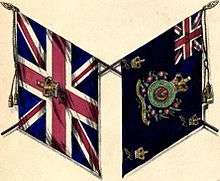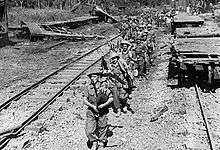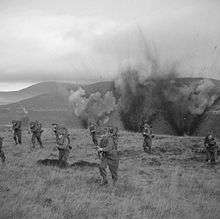Royal Scots Fusiliers
| Royal Scots Fusiliers | |
|---|---|
|
Regimental cap badge | |
| Active | 1678–1959 |
| Country |
|
| Branch |
|
| Type | Infantry |
| Role | Line infantry |
| Part of | Lowland Brigade |
| Garrison/HQ | Churchill Barracks, Ayr |
| Insignia | |
| Hackle | White |
| Tartan | Hunting Erskine |
The Royal Scots Fusiliers was a line infantry regiment of the British Army that existed from 1678 until 1959 when it was amalgamated with the Highland Light Infantry (City of Glasgow Regiment) to form the Royal Highland Fusiliers (Princess Margaret's Own Glasgow and Ayrshire Regiment) which was later itself merged with the Royal Scots Borderers, the Black Watch (Royal Highland Regiment), the Argyll and Sutherland Highlanders and the Highlanders (Seaforth, Gordons and Camerons) to form a new large regiment, the Royal Regiment of Scotland.
History

The Earl of Mar's Regiment of Foot ('Mar's Grey Breeks') (1678–1695)
The regiment was raised in Scotland in 1678 by Stuart loyalist Charles Erskine, de jure 5th Earl of Mar for service against the rebel covenanting forces during the Second Whig Revolt (1678–1679).[1] It was used to keep the peace and put down brigands, mercenaries, and rebels. In the Glorious Revolution of 1688, the regiment was ordered south.[2] Initially, it stayed loyal to James II of England; however, when he fled to Ireland, it opted to serve Prince William of Orange.[3]
The Scots Fusilier Regiment of Foot (1685–1707)
The regiment was converted to fusiliers in 1685.[4] It was nicknamed the "Duke of Marlborough's Own" for its excellent service in all of the Duke's campaigns in the War of the Spanish Succession.[5]
The North British Fusilier Regiment of Foot (1707–1713)
The regiment was renamed the North British Fusilier Regiment of Foot in 1707 reflecting Treaty of Union that led to the creation of Great Britain.[4]
21st (Royal North British Fusilier) Regiment of Foot (1713–1877)
The regiment was awarded the title "Royal" around 1713.[6] The regiment saw action under the command of Sir Andrew Agnew at the Battle of Dettingen in June 1743 during the War of the Austrian Succession[7] and later fought against the Jacobites at the Battle of Culloden in April 1746 during the Second Jacobite Rebellion.[8] It was numbered the 21st Regiment in 1751, when seniority numbers were introduced.[4]
The regiment saw action at the Siege of Fort Ticonderoga in July 1777 during the American Revolutionary War,[9] took part in the Siege of Bergen op Zoom in March 1814 during the Napoleonic Wars[10] and saw combat at the Battle of New Orleans in January 1815 during the War of 1812.[11] The regiment then served under the command of Lieutenant Colonel Frederick Haines at the Battle of Inkerman in November 1854 during the Crimean War.[12]
21st (Royal Scots Fusiliers) Regiment of Foot (1877–1881)
The regiment finally saw the restoration of "Scots" in their title in 1877.[4]

Childers Reforms
The regiment did not suffer the indignity of being amalgamated, as it already had two regular battalions. However, it did become the County Regiment of Ayrshire, Dumfriesshire, Kirkcudbrightshire, Roxburghshire, Selkirkshire and Wigtownshire in South-West Scotland. This made them a Lowland Regiment and forced them to adopt trews. It also had to lose its numbering, becoming the Royal Scots Fusiliers.[4] The regiment saw action at the Battle of the Tugela Heights in February 1900 during the Second Boer War.[13] Captain Hugh Trenchard was seriously wounded while serving with the regiment near Krugersdorp at this time.[14]
First World War

The 1st Battalion landed at Le Havre as part of 9th Brigade in the 3rd Division in August 1914 for service on the Western Front.[15] It saw action at the Battle of Mons in August 1914, the First Battle of Ypres in October 1914, Battle of the Somme in Summer 1916, the Battle of Arras in April 1917 and the advance to the Hindenburg Line in September 1918[16] and was commanded by Lieutenant Colonel Deneys Reitz in the closing stages of the war.[17]
The 2nd Battalion landed at Zeebrugge as part of the 21st Brigade in the 7th Division in October 1914 for service on the Western Front.[15] It saw action at the First Battle of Ypres in October 1914, the Battle of Neuve Chapelle in March 1915, the Battle of Loos in October 1915, the Battle of the Somme in Summer 1916, the Battle of Arras in April 1917 and the Battle of Lys in April 1918.[16]
The 1/4th and 1/5th Battalions landed in Gallipoli as part of the 155th Brigade in the 52nd (Lowland) Division in June 1915; after being evacuated in January 1916 they moved to France in April 1918 for service on the Western Front.[15]
The 6th (Service) Battalion landed at Boulogne-sur-Mer as part of the 27th Brigade in the 9th (Scottish) Division in May 1915 for service on the Western Front.[15] Lieutenant Colonel Winston Churchill commanded the battalion when it was located near Ploegsteert Wood during Spring 1916.[18] The 7th (Service) Battalion landed at Boulogne-sur-Mer as part of the 45th Brigade in the 15th (Scottish) Division in July 1915 for service on the Western Front.[15] The 8th (Service) Battalion landed at Boulogne-sur-Mer as part of the 77th Brigade in the 26th Division in September 1915 for service on the Western Front but soon moved to Salonika.[15]
Second World War
In the Second World War, the regiment served in North-West Europe, Sicily and Italy, Madagascar and Burma. The 1st Battalion spent the whole war as part of the 29th Independent Infantry Brigade Group. The battalion participated in the Battle of Madagascar in 1942 as did the 2nd Battalion, a unique achievement for the regiment to have both its regular battalions involved in the same action. They were then transferred to British India to fight in the South-East Asian Theatre.[19] In 1944 the 29th Brigade became part of the 36th Infantry Division,[20] previously a British Indian Army formation and one of two British divisions fighting the Japanese, the other being the 2nd Infantry Division although many Indian divisions included British units under command. The 36th Division spent the rest of the war under command of the British Fourteenth Army.[21]

The 2nd Battalion, Royal Scots Fusiliers was serving in Edinburgh on the outbreak of war under Scottish Command.[22] In early October 1939 the battalion was grouped with the 2nd Seaforth Highlanders and 2nd Northants to create the 17th Infantry Brigade, which was assigned to the 5th Infantry Division.[23] They were sent as an independent brigade group to France in late 1939 to join the rest of the British Expeditionary Force (BEF) and were involved in the Battle of Dunkirk and had to be evacuated to England. After 2 years spent on home defence in the United Kingdom, the battalion and brigade were detached from the 5th Division, and like the 1st Battalion, fought in Madagascar. The battalion next saw service fighting in Sicily. In 1944 the division fought in the Battle of Anzio in some of the fiercest fighting of the Italian Campaign thus far. The Anzio landings were an attempt to outflank the German Gustav Line, one of many defensive lines the Germans had created across Italy.[24] After the fierce fighting there, the 2nd RSF and the rest of 5th Division were withdrawn, in July 1944, to Palestine to rest and refit. They returned to Italy briefly in early 1945 but were transferred, along with I Canadian Corps from British Eighth Army, to Belgium to join the 21st Army Group in the Allied invasion of Germany.[25]
The 4/5th and 6th battalions both saw service in the European Campaign in 1944-1945 with the 6th also serving in France in 1940, assigned to 51st (Highland) Infantry Division and part of the BEF. The 4/5th Battalion was the TA 4th and 5th battalions merged and became part of 156th Infantry Brigade assigned to the 52nd (Lowland) Infantry Division. Lieutenant Colonel Thomas Corbett commanded the 6th Battalion during the Battle of France in June 1940.[26] The 6th Battalion was reassigned to the 46th Infantry Brigade part of 15th (Scottish) Infantry Division, the 2nd Line duplicate of the 52nd, and served with them during the Battle of Normandy.[27]

The 50th (Holding) Battalion was raised in late May 1940 and was later redesignated the 11th Battalion in October and was assigned to the 222nd Infantry Brigade, where it remained until September 1942 when it transferred to the 147th Infantry Brigade, alongside the 1/6th and 1/7th Duke of Wellington's Regiment, part of the 49th (West Riding) Infantry Division, where it was to remain for the rest of the war.[28]
Amalgamations of 1959
The Royal Scots Fusiliers were amalgamated with the Highland Light Infantry (City of Glasgow Regiment) in 1959 to form the Royal Highland Fusiliers, (Princess Margaret's Own Glasgow and Ayrshire Regiment). The regular 1st battalions of the two Regiments combined at Redford Barracks, Edinburgh to form the 1st Battalion of the new regiment (1 RHF).[29]
Battle honours
The Regiment was awarded the following battle honours. Those shown in bold from the two World Wars were those selected to be emblazoned on the King's Colour.[4]
- Blenheim, Ramillies, Oudenarde, Malplaquet, Dettingen, Bellisle, Martinique 1794, Bladensburg, Alma, Inkerman, Sevastopol, South Africa 1879, Burma 1885–87, Tirah, Relief of Ladysmith, South Africa 1899–1902
- The Great War (18 battalions): Mons, Le Cateau, Retreat from Mons, Marne 1914, Aisne 1914, La Bassée 1914, Ypres 1914 '17 '18, Langemarck 1914, Gheluvelt, Nonne Bosschen, Neuve Chapelle, Aubers, Festubert 1915, Loos, Somme 1916 '18, Albert 1916 '18, Bazentin, Delville Wood, Pozières, Flers-Courcelette, Le Transloy, Ancre Heights, Ancre 1916, Arras 1917 '18, Scarpe 1917 '18, Arleux, Messines 1917, Pilckem, Menin Road, Polygon Wood, St Quentin, Bapaume 1918, Rosières, Lys, Estaires, Hazebrouck, Bailleul, Béthune, Scherpenberg, Drocourt-Quéant, Hindenberg Line, Canal du Nord, Courtrai, Selle, France and Flanders 1914–18, Doiran 1917 '18, Macedonia 1916–18, Helles, Gallipoli 1915–16, Rumani, Egypt 1916–17, Gaza, El Mughar, Nebi Samwil, Jerusalem, Jaffa, Tel Asur, Palestine 1917–18
- The Second World War: Defence of Arras, Ypres-Comines Canal, Somme 1940, Withdrawal to Seine, Odon, Fontenay le Pesnil, Cheux, Defence of Rauray, Mont Pincon, Estry, Falaise, Le Vie Crossing, La Touques Crossing, Aart, Nederrijn, Best, Le Havre, Antwerp-Turnhout Canal, Scheldt, South Beveland, Lower Maas, Meijel, Venlo Pocket, Roer, Rhineland, Reichswald, Cleve, Goch, Rhine, Dreirwalde, Uelzen, Bremen, Artlenberg, North-West Europe 1940 '44–45, Landing in Sicily, Sicily 1943, Sangro, Garigliano Crossing, Minturno, Anzio, Advance to Tiber, Italy 1943–44, Madagascar, Middle East 1942, North Arakan, Razabil, Pinwe, Shweli, Mandalay, Burma 1944–45
- 4th Battalion: South Africa 1900–02
- 5th Battalion: South Africa 1900–01
Victoria Crosses
Victoria Crosses awarded to members of the regiment were:
- Second Lieutenant Stanley Henry Parry Boughey, First World War (1 December 1917)
- Sergeant Thomas Caldwell, First World War (31 October 1918}
- Second Lieutenant John Manson Craig, First World War (5 June 1917}
- Fusilier Dennis Donnini, Second World War (18 January 1945)
- Private David Ross Lauder, First World War (13 August 1915)
- Private George Ravenhill, Second Boer War (15 December 1899)
Colonels of the Regiment
Colonels of the regiment were: [30]
- 1678–1686: Col. Charles Erskine, 5th Earl of Mar (Lord Erskine)
The Scots Fusiliers
- 1686–1689: Col. Thomas Buchan
21st Regiment of Foot
- 1689–1695: Brig-Gen. Francis Fergus O'Farrell
- 1695–1697: Col. Hon. Robert Mackay
- 1697–1704: Col. Archibald Rowe
- 1704–1706: Brig-Gen. John Mordaunt, Viscount Mordaunt
- 1706–1709: Maj-Gen. Sampson de Lalo
The North British Fusiliers
- 1709–1710: Brig-Gen. John Mordaunt, Viscount Mordaunt [reappointed]
- 1710: Lt-Gen. Thomas Meredyth [cashiered 1710)
- 1710–1716: Maj-Gen. Charles Boyle, 4th Earl of Orrery, KT
The Royal North British Fusiliers
- 1716–1727: Lt-Gen. George MacCartney
- 1727–1738: Maj-Gen. Sir James Wood, 2nd Baronet
- 1738–1752: Gen. John Campbell, 4th Duke of Argyll, KT
21st (Royal North British) Fusiliers
- 1752–1770: Gen. William Maule, 1st Earl of Panmure
- 1770–1789: Lt-Gen. Hon. Alexander Mackay
- 1789–1794: Gen. Hon. James Murray
- 1794–1803: Gen. James Inglis Hamilton
- 1803–1816: Gen. Hon. William Gordon of Fyvie
- 1816–1843: Gen. James Ochoncar Forbes, 17th Baron Forbes
- 1843–1853: Gen. Sir Frederick Adam, GCB, GCMG
- 1853–1870: Gen. Sir George de Lacey Evans, GCB
- 1870–1890: Gen. Sir Frederick William Hamilton. KCB
The Royal Scots Fusiliers
- 1890–1909: F.M. Sir Frederick Paul Haines, GCB, GCSI, CIE
- 1909–1919: Lt-Gen. John Thomas Dalyell
- 1919–1946: Marshal of the RAF (Col.) Hugh Montague Trenchard, 1st Viscount Trenchard, GCB
- 1946–1957: Maj-Gen. Sir Edmund Hakewill Smith, KCVO, CB, CBE, MC
- 1957–1959: Brig. Archibald Ian Buchanan-Dunlop, CBE, DSO
References
- ↑ Cannon, p. 1
- ↑ Cannon, p. 3
- ↑ Cannon, p. 4
- 1 2 3 4 5 6 "Royal Scots Fusiliers". Regiments.org. Archived from the original on 12 July 2006. Retrieved 7 May 2016.
- ↑ "Royal Scots Fusiliers". Hebridean Connections. Retrieved 7 May 2016.
- ↑ Cannon, p. 17
- ↑ Journal of the Royal Highland Fusiliers Volume 24, No 2 (Winter 2000), Major Sir Crispin Agnew of Lochnaw, Bt.
- ↑ Cannon, p. 22
- ↑ Cannon, p. 26
- ↑ Cannon, p. 38
- ↑ Cannon, p. 42
- ↑ Heathcote, p. 164
- ↑ "Royal Scots Fusiliers". Anglo-Boer War. Retrieved 7 May 2016.
- ↑ Buchan, p. 274
- 1 2 3 4 5 6 "Royal Scots Fusiliers". The Long, Long Trail. Retrieved 7 May 2016.
- 1 2 "1914-1939". Royal Highland Fusiliers. Retrieved 7 May 2016.
- ↑ Reitz, Deneys; JC Smuts (2008). Commando: A Boer Journal of the Boer War. CruGuru. p. 336. ISBN 978-1-920265-68-7.
- ↑ Jenkins, p. 301
- ↑ Joslen, p. 277
- ↑ "36th Division". Unit Histories. Retrieved 7 May 2016.
- ↑ "14th Army". Burna Star Association. Retrieved 7 May 2016.
- ↑ "Lowland Area" (PDF). British military history. Retrieved 31 August 2015.
- ↑ "badge, formation, 5th Infantry Division". Imperial War Museum. Retrieved 7 May 2016.
- ↑ "5th Division". Battlefields. Retrieved 7 May 2016.
- ↑ "1939-1945". Royal Highland Fusiliers. Retrieved 7 May 2016.
- ↑ Rowallan, foreword, page x
- ↑ Joslen, pp. 58–9
- ↑ Joslen, p. 332
- ↑ "Royal Highland Fusiliers". British Army units 1945 on. Retrieved 25 May 2014.
- ↑ "Royal Scots Fusiliers". Regiments.org. Retrieved 10 July 2016.
Sources
- Buchan, John (2005) [1925]. The History of the Royal Scots Fusiliers. The Naval & Military Press.
- Cannon, Richard (1849). Historical Record of the Twenty-First or Royal North British Fusilier Regiment of Foot.
- Jenkins, Roy (2001). Churchill: A Biography. Farrar, Straus and Giroux. ISBN 978-0-374-12354-3.
- Joslen, H.F. (1960). Orders of Battle, Volume 1: United Kingdom and Colonial Formations and Units in the Second World War 1939–1945. London: HMSO.
- Heathcote, Tony (1999). The British Field Marshals, 1736–1997: A Biographical Dictionary. Barnsley: Leo Cooper. ISBN 0-85052-696-5.
- Rowallan, Lord (1976). Rowallan: the autobiography of Lord Rowallan. Paul Harris Publishing. ISBN 0-919670-12-1.
Further reading
- Kemp, Colonel J C (1963). The Royal Scots Fusiliers 1920–1959. Robert MacLehose.
External links
| Wikimedia Commons has media related to Royal Scots Fusiliers. |
| Wikimedia Commons has media related to Churchill in the Trenches. |

